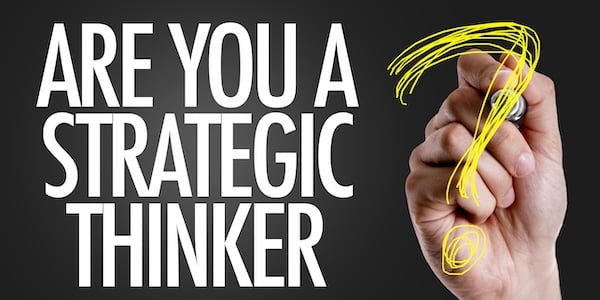Why is Strategic Thinking Important - now more than ever
For years, “strategic thinking” has been reserved for executive team meetings or board rooms as part of a firm’s strategic planning process. However,...
2 min read
.webp) Cecilia Lynch
Jun 20, 2017 10:50:53 AM
Cecilia Lynch
Jun 20, 2017 10:50:53 AM

The aim of strategic thinking is to add value to your business, maximize your resources and act as a catalyst for creating a competitive advantage. However, it doesn’t just automatically happen. Individuals and organizations must actively work to create an environment that is conducive to it. In this four-part series, I detail the four basic conditions that foster strategic thinking, including shifting from a transactional mindset; suspending the problem-solving mindset; disrupting your thinking, and exploring the broader context.
In Part 1 of this series, I examine the first condition, shifting from a transactional mindset.
A transactional mindset is focusing on the quantifiable activities of your business. Today the tools available to access and analyze data make the transactional mindset extremely seductive. It can be hard to pull away and shift your perspective to more contextual exploration. But exclusively focusing on transactions can set up a dangerous progression. This danger is like walking while focusing just on your feet. If you stay focused on your next step all the time, and forget to pop your head up every once and a while to take in your environment, you might just to bump into something or worse, end up in a place you didn’t want to be.
Strategic thinking, on the other hand, is when you add to your transactional focus with increased awareness of the environment around you and with your vision trained on your ultimate goals rather than just your next step. It is the equivalent of looking out and ahead so you know if the steps you are taking today will lead you to the place you want to be tomorrow.
So, how do you shift from a transactional mindset to a more strategic one? For many, turning their attention away from business transactions seems risky, especially if this focus has led to your current success. However, I am not suggesting a complete switch I am suggesting that you develop a practice of including strategic thinking in your decision-making process regularly.
Making the shift can be accomplished as easily as bench-marking your performance against market growth. If your plans are to achieve 3% growth and you achieve 5%, you may want to celebrate. But if your market is growing at 8% you are falling behind, and it is not a time for celebration. Ideally, you want to add an environmental scan step to each management decision process. While compiling your analysis, make sure you contextualize it with external data or insights. Don’t make a decision unless you have an option that replicates what others are doing. At every opportunity, pop your head up and see what is going on around you. Make sure your next step is aligned with the direction you want to go.
Shifting from the transactional mindset helps foster strategic thinking in individuals and organizations. It ensures vitality and keeps you agile to catch the next wave, so you achieve and maintain a competitive advantage.

For years, “strategic thinking” has been reserved for executive team meetings or board rooms as part of a firm’s strategic planning process. However,...

Strategic thinking aimsto add value to your business, maximize your resources and act as a catalyst for positive change. It doesn’t just...

The aim of strategic thinkingis to add value to your business, maximize your resources and act as a catalyst for creating competitive advantage. ...